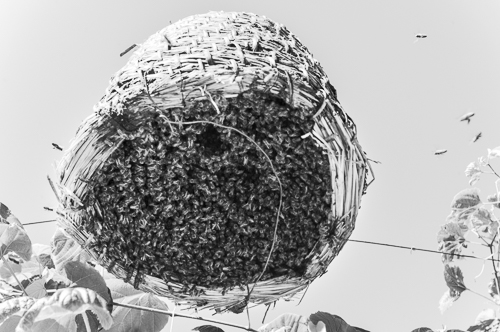On our last day in Crit we walked to the beekeeper in the morning, arriving at another cobbled courtyard. After both of us had got dressed in protective clothing from head to toe, we entered the garden of the Pandrea family. There, we first saw a big coach whose wall facing us was covered with colourful squares. Approaching further, we could see that there was a small, rectangular opening at the base of each square where bees where entering and exiting as they wished.
The coach, being wide as a car and with wheels, was similar to other coaches we had seen on our trips in Transylvania, being freighted by car wherever the owner wished. On the contrary, this coach seemed like it was meant to stay in its place forever. We were offered to enter, and inside, there was another series of squares with texts written on them by chalk. We were told that they were for indicating when the beehive had been inspected and the quality of the honey. Bees which didn’t produce honey were transferred to other beehives where they were fed something nutritious.
Since the beekeeper was rather old and frail being more than 80, he’s letting his son Emil be in charge of the beekeeping. Both of them willingly told us about what they were doing. While we wore protective clothing, they were only wearing a hood with netting to protect their faces. They opened several of their beehives, lifted up wooden frames with a plate consisting of hexagonal holes called a honeycomb. Sometimes the whole plate was full of bees and quite often Emil showed us how to identify the queen. He even put his fingers into the mass of bees in order to pick one of them out for us to have a look. Of course, the bees got very angry and they were flying around me, trying to pass the protective netting around my face. Luckily, they didn’t succeed. In any case, Emil brought a small container from which smoke was exiting continuously. A light “shower” of smoke before entering the beehive was their standard procedure although I have no idea how effective it was.
Teofil showed us a tiny metal box whose walls were covered with netting. They used it for transferring queen bees to beehives without a queen. First, they put the queen bee inside the box, then they close the box by means of beeswax and put it inside a beehive. If the bees like the smell of the new queen bee, they will eat the beeswax and let the queen bee out. If not, they have to insert another queen bee into the beehive.
In addition to their more or less standard beehives, Teofil showed us a beehive from the middle ages which he had mounted near to their house. It looked like a basket formed like a wide cone with the opening facing downwards, and it was full of bees as can be seen from one of the photos. Searching for the history of beekeeping, I found out that beehives until about 1850 were shelters only and that was what that “basket” looked like.

